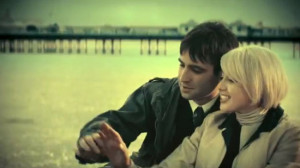In recent times, I've found myself getting down on the Mods! book, but I've come to realize there are really only two reasons why I don't like this book:
- Some people rely too heavily on it as the end-all and be-all of Mod thinking and,
- According to what you hear from original Mods who were around during the time-frame of the book, their were other local scenes left out of the history. We only received info on a portion of the 1960s Mod scene.
Think about it... Richard Barnes, helped by Johnny Moke & Jan McVeigh (or the other way around, I'm not sure), pack an enormous amount of detailed information into only 18 pages of text. Eighteen! And these few pages have inspired so many people over the years... they've helped keep alive a vibrant subculture more than any other book since. And sure, many great books have come along, but none have had the impact Mods! has had.
And talk about 'attention to detail,' man... Mods! has it in droves! It's this attention to detail that many of us have eaten up, absorbed, and reflected in our own personal styles. And this detailed text is probably why some treat it as a Bible that must not be disobeyed.
Yes, some people practically keep this book in their back pocket, ready to pull it out at a moment's notice to call out Mod fashion offenses. (Guilty!) And this does become a complete drag when people use it to limit their outlook on the culture.
In reaction, many out there now call out that 'there are no rules' when it comes to the Mod thing. I can see their point... to a point. But, lately, thinking about this more, something troubles me about this. After discussing with a friend, a good point was brought up. Claiming there are no rules sort of makes it easy to get away with abandoning what makes the Mod thing so special: those perceived 'rules'.
You can ignore the types of details brought up in the Mods! book and just walk around in a nice, well-tailored suit, calling yourself a Mod simply because you're wearing a nice suit. But, at least for me, that's not what necessarily makes a 'Mod' look. If that were the case, these guys could start calling themselves Mods and, who are we to argue, if there are no rules:
 |
| Bryan Ferry |
 |
| Interpol |
 |
| Nick Cave |
We even had our own rules we developed when we were younger. I remember we had our rules geared toward belts and belt loops: loops had to be around 2 inches wide and the belt had to have a center buckle (Thanks, Paola, for reminding me about this!). We had attitudes toward how shirt collars were worn. Had to be held down, either by buttons, collar pins, or tabs (the last two needed a tie, of course). If you weren't wearing a tie, you didn't button the top button of the shirt... why look uptight? I remember altering some shirts to add in fake buttons just so it'd look like I was wearing a button-down collar. I still have one of those shirts!
Although I wasn't around, I do remember hearing about rules the San Francisco Mods had toward their dress. I remember hearing about the rules Berkeley Mods had toward their dress. Heck, maybe you and your friends developed your own rules too, adopted from what you learned from Mods!.
Okay, look... it's like photography, music, or art. (Yes, I'm going there.) In photography, there are rules of composition. In music theory, there are rules involved with chord progressions. And in painting/drawing, there are rules involved with color theory, composition, and harmony. Most of the world's greatest masters knew these rules in their particular fields. But knowing these rules meant they also knew how to break them. And that's the key. By breaking the rules, they were able to push those fields forward. Like many have said before, remember, Picasso did know how to draw.
Yeah, that's what the Mod thing is like for me. There are rules. You learn these rules, maybe become obsessed with them. And, from there, you learn how to work around them if needed. I see some Mod fellows (and ladies) online who look incredibly 'Mod' while breaking traditional rules we've learned from the Mods! book. It's almost as if there's a conscious move to ignore a particular 'rule' (button count, tie width, jacket vent. Ahem... like this guy.)
And yeah, many of these 'rules' are what were described in that Mods! book. I'm looking through it now and finding myself filled with the same excitement I had when I first started learning about Mod stuff. Even when I get down on this book, I can never ignore the impact it's had on me and many others. This is the book that taught me what 'attention to detail' really meant. It taught me the detailed basics of a Mod jacket. It taught me what backcombing was. It taught me what chisel-toed shoes were. And it taught me that, yes, there is a framework to the Mod look that we can use today and, if we understand the 'rules,' we can know how to break them.
And remember, there's so much more to a Mod look that just being stylish. Pick up the Mods! book and see for yourself.
*







